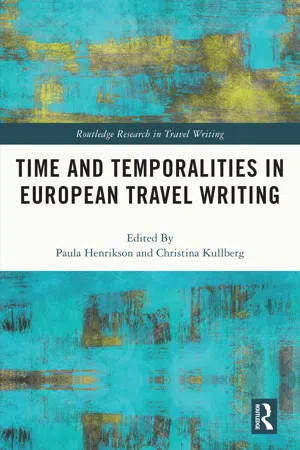
- 232 pages
- English
- ePUB (mobile friendly)
- Available on iOS & Android
Time and Temporalities in European Travel Writing
About This Book
This book is a collective effort to investigate and problematise notions of time and temporality in European travel writing from the late medieval period up to the late nineteenth century. It brings together nine researchers in European travel writing and covers a wide range of areas, travel genres, and languages, coherently integrated around the central theme of time and temporalities. Taken together, the contributions consider how temporal aspects evolve and change in regard to spatial, historical, and literary contexts. In a chapter-by-chapter account this volume thus offers various case studies that address the issue of temporality by showing, for example, how time is inscribed in landscape, how travellers' encounters with other temporalities informed other disciplines; it interrogates the idea of "cultural temporalities" in regard to a tension between past and future, passivity and progression; and focuses on how time is entangled in identity construction proper to travelogues.
Frequently asked questions
Information
1 Time and Temporality in Travel Accounts from the Fourteenth to Sixteenth Centuries*
Mandeville, Tucher, Ecklin
Outlines of Christian Spatiotemporality
In Jerusalem, there are two large pools at the side of the temple, that is, one on the right hand, and one on the left, which were made by Solomon; and further in the city are twin pools, with five porticoes, which are called Bethsaida. Persons who have been sick for many years are cured there; the pools contain water that is red when it is disturbed. There is also a crypt here, in which Solomon used to torture devils. Here is also the corner of an exceedingly high tower, where our Lord ascended and the tempter said to Him, ‘If thou be the Son of God, cast thyself down from hence.’ And the Lord answered, ‘Thou shalt not tempt the Lord thy God, but him only shalt thou serve.’5
Table of contents
- Cover
- Half Title
- Series Page
- Title Page
- Copyright Page
- Table of Contents
- List of Figures
- List of Contributors
- Introduction*: Time, Temporality, and Travel Writing
- Chapter 1: Time and Temporality in Travel Accounts from the Fourteenth to Sixteenth Centuries*: Mandeville, Tucher, Ecklin
- Chapter 2: Like Moses on the Nile*: Competing Temporalities in Jean-Baptiste Du Tertre’s Histoire générale des Antilles habitées par les François (1654/1667)
- Chapter 3: Signs of Travel and Memory*: The Case of the Wooden Slabs in Jukkasjärvi (1681–1736)
- Chapter 4: Almanacs, Polytemporality, and Early Modern Travel
- Chapter 5: Time Travel in the Pacific*: Maritime Exploration and Eighteenth-Century German Historiography
- Chapter 6: Ruins and Revolutions*: Jacob Berggren on Classical Soil
- Chapter 7: Jerusalem in Every Soul*: Temporalities of Faith in Fredrika Bremer’s and Harriet Martineau’s Travel Narratives of Palestine
- Chapter 8: Temporalities of the Anti-Modern: Angel Ganivet’s Neo-Romantic Mapping of Western Civilisation
- Index